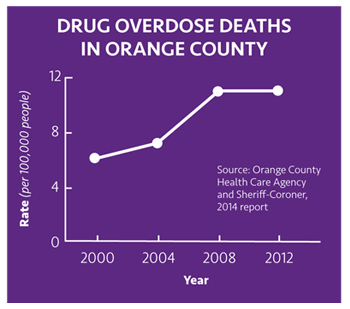Battling prescription drug abuse in orange county
June 16, 2016
UCI Health has helped launch a countywide initiative aimed at curbing opioid drug abuse and assisting patients who are dependent.
What began about 15 years ago as a well-intentioned campaign to
better treat people with chronic pain has today mushroomed into
an epidemic of prescription drug abuse across the country.
U.S.
deaths from prescription painkillers, typically opioid medications, quadrupled
from 1999 to 2013, according to the federal government.
This grim picture is much the same in Orange County. That’s why UC Irvine
Health has helped launch a countywide initiative aimed at curbing opioid drug
abuse and assisting patients who are dependent.
“As a pain physician, having seen this problem evolve, I can’t help but feel
the need to play a prominent role to reverse this trend,” says Dr. Padma Gulur,
director of the UCI Health Center for Pain Management & Wellness.
Gulur has led the effort to establish the Orange County Collaborative
on Prescription Drug Abuse. The coalition, which was founded late last
year, is made up of health professionals, educators, health insurers, law
enforcement officials and others who are joining forces to address the
opioid drug abuse problem in Orange County.
No region of the nation is free from prescription drug abuse, Gulur
says. According to a 2014 report from the Orange County Health Care
Agency and Sheriff-Coroner’s Office, the
rate of drug overdose deaths increased 61
percent between 2000 and 2012.
“It’s affecting every strata of society,”
she says. “It’s no longer someone else’s
problem.”
In her own practice, Gulur works with
patients to identify a range of options
to alleviate pain. For too long, however,
physicians around the country relied heavily
on prescribing opioids.
 “Back in the 1990s there was a concern
that we were under-treating pain. From
2003 to 2008, prescription drug use went up
dramatically,” she says. “Science has taught
us that pain requires multimodal care:
complementary and alternative medicine,
lifestyle modification, nutrition as well as
medications or medical interventions. But there has been a tendency to rely
almost exclusively on this class of medications.”
“Back in the 1990s there was a concern
that we were under-treating pain. From
2003 to 2008, prescription drug use went up
dramatically,” she says. “Science has taught
us that pain requires multimodal care:
complementary and alternative medicine,
lifestyle modification, nutrition as well as
medications or medical interventions. But there has been a tendency to rely
almost exclusively on this class of medications.”
Anyone can become addicted, she adds. “It’s the medicine, not the
people. This is what these medications do to our system. Addiction can
affect anybody.”
The collaborative includes individuals who have experienced the
heartbreaking toll of prescription drug abuse in their families, such as
Aimee Dunkle, executive director and co-founder of the Solace Foundation
of Orange County. The foundation works to reduce overdose deaths
through the use of naloxone, a potentially lifesaving medication that can
be administered to someone suffering an opioid overdose. Dunkle’s son
died of an opioid overdose in 2012.
“If you look at the statistics on opioid drug abuse in California, it doesn’t
look that bad,” Dunkle says. “But when you look at counties separately,
like Orange County, you realize there are pockets with unbelievably high
overdose rates. The collaboration represents the community coming
together to do something.”
The group will focus on training doctors about “safe prescribing practices”
to treat pain while minimizing the risk of addiction. Efforts will be made to
educate people on the proper storage and disposal of opioids.
The collaborative aims to improve the
treatment options for Orange County
residents who are addicted to opioids and to
increase the use of naloxone.
“When my son overdosed three years ago,
he was with three people who did nothing.
If they had naloxone, they would have used
it,” Dunkle says. “The collaboration can
work on getting the funding and support for
distributing naloxone.”
The group hopes to see a 20 percent
drop in opioid deaths, which are usually
accidental, in 18 months. Similar initiatives
have been successful in Marin and San
Diego counties. UCI Health is a
natural choice to lead the Orange County
campaign, Gulur says.
“We are the academic institution for
this area,” she says.
“We are training the next generation of physicians and
prescribers. We need to lead by example. While we have done a lot within our
own health system to address this issue, we have to recognize that we are one
part of a larger community and we have to address the larger problem.”
The coalition, which has been funded by a grant from the California
Healthcare Foundation, is off to a strong start, she adds. “Seeing everyone
come together is very fulfilling. When I have picked up the phone or asked
to meet someone, I’ve seen nothing but open-hearted support to try to
address this.”
Learn more about the Orange County Collaborative on Prescription Drug Abuse at saferxoc.org and about pain management at ucirvinehealth.org/pain.
— UCI Health Marketing & Communications
Featured in UCI Health Live Well Magazine Summer 2016
